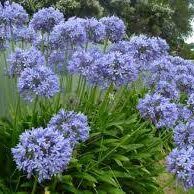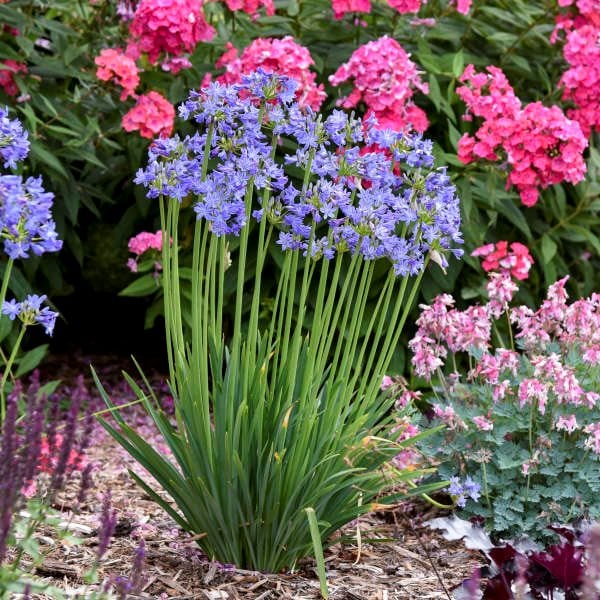Magnificent Agapanthus: Enhancing Your Yard's Elegance
Magnificent Agapanthus: Enhancing Your Yard's Elegance
Blog Article
Mastering the Art of Agapanthus Treatment: Important Actions for Healthy Development and Vivid Blooms
In the world of cultivation, the farming of agapanthus stands as a satisfying undertaking for those who seek to support these sophisticated flowering plants. From selecting the appropriate selection to grasping pruning methods, the journey in the direction of growing thriving agapanthus plants is multifaceted and holds the essential to unlocking the complete possibility of these agricultural treasures.

Picking the Right Agapanthus Selection

When selecting the right Agapanthus range for your garden, take into consideration factors such as climate suitability, flower color, and development routine. Agapanthus, typically called Lily of the Nile or African lily, is available in a range of colors varying from tones of purple and blue to white. Select a flower color that enhances your existing yard palette to develop an unified landscape. Furthermore, take into consideration the climate in your region to make sure the Agapanthus selection you choose can thrive in your certain problems. Some ranges are extra tolerant of cool temperatures, while others prefer warmer climates. Recognizing the growth behavior of different Agapanthus varieties is important for proper placement within your yard. Some ranges have a clumping growth habit, suitable for borders or containers, while others have a more dispersing nature, suitable for ground cover or mass plantings. By very carefully examining these elements, you can choose the ideal Agapanthus selection to improve the charm of your garden.
Suitable Planting Problems
Taking into consideration the ideal ecological demands is important for effective Agapanthus farming. Agapanthus flourishes in well-draining soil with a slightly acidic to neutral pH degree. When planting, pick a location that gets full sunshine to partial shade. In hotter climates, providing some mid-day shade can protect against scorching of the leaves. Agapanthus plants are delicate to cold temperatures and should be secured from frost during cold weather.
To ensure healthy growth and lively blossoms, plant Agapanthus bulbs at a deepness of about 2-4 inches and area them 8-12 inches apart. Mulching around the base of the plants assists preserve dampness and reduces weed development.
Watering and Feeding Tips
Keeping correct wetness levels and supplying vital nutrients are crucial elements in the care program for Agapanthus plants. It is critical to strike a balance when it comes to sprinkling Agapanthus. These plants favor continually moist soil however are vulnerable to root rot if overwatered. During the growing season, water deeply once a week, guaranteeing the soil is well-draining to stop waterlogging. In hotter environments or throughout durations of drought, more regular watering might be needed to keep the soil equally moist. However, reduce watering in the winter to protect against water logged problems.
Feeding Agapanthus is vital for promoting healthy and balanced growth and prolific blooms. Use a balanced fertilizer, such as a 10-10-10 formula, in the early spring as brand-new growth emerges. By adhering to these watering and feeding suggestions, you can ensure your Agapanthus plants grow and create lively, durable blooms.
Pruning Methods for Agapanthus
Trimming Agapanthus plants at the appropriate times and with correct methods is crucial for preserving their health and advertising optimal development and flowering. The perfect time to trim Agapanthus remains in late winter next page or early springtime before new growth arises. Start by eliminating any dead or yellowing leaves near the base of the plant. Cut them as close to the ground as possible without harming the emerging shoots.
Deadheading spent flowers can likewise redirect the plant's energy right into generating more flowers instead than establishing seeds. If you want to collect seeds for propagation, leave some blossoms to dry and fully grown look these up on the plant.
Keep in mind to utilize clean, sharp tools to make precise cuts and reduce the danger of presenting diseases. Agapanthus. Normal pruning will certainly aid maintain your Agapanthus looking healthy and neat while guaranteeing an abundant display screen of stunning blooms
Taking Care Of Common Pests and Illness
After ensuring proper trimming methods for Agapanthus, it is necessary to deal with usual insects and illness that can influence the health and wellness and vigor of these plants. Agapanthus plants are usually sturdy yet can still succumb specific problems. One usual bug that impacts Agapanthus is the Agapanthus gall midget. This tiny, orange fly lays its eggs in the foliage, resulting in altered development and blossom buds that stop working to open. To fight this pest, trim and ruin any affected plant parts and think about utilizing insecticidal soap.
An additional common problem is fungal leaf spot, which provides as dark sores on the leaves. To avoid fungal conditions, ensure excellent air blood circulation around the plants, stay clear of overhanging watering, and eliminate any infected fallen leaves without delay. Additionally, Agapanthus plants can deal with root rot if they are planted in improperly draining pipes soil. To stop this, plant Agapanthus in well-draining soil and stay clear of overwatering. By being attentive and taking punctual action against bugs and illness, you can help your Agapanthus plants grow and produce dynamic flowers.

Conclusion
To conclude, understanding the art of agapanthus care entails choosing the best variety, supplying perfect growing conditions, appropriate watering and feeding, suitable pruning techniques, and resolving typical insects and conditions. By complying with these necessary steps, you can make certain healthy and balanced growth and dynamic flowers for your agapanthus plants. Remember to regularly check and maintain your plants to advertise their total wellness and longevity.
To make certain healthy and balanced development and vivid blooms, plant Agapanthus bulbs at a depth of concerning 2-4 inches and room them 8-12 inches apart. By following these watering and feeding suggestions, you can guarantee your Agapanthus plants grow and generate dynamic, durable blossoms.
One common bug that influences Agapanthus is the Agapanthus gall midget. In addition, Agapanthus plants can suffer from root rot if they are planted more helpful hints in poorly draining pipes soil. By following these crucial steps, you can make sure healthy and balanced growth and lively flowers for your agapanthus plants.
Report this page